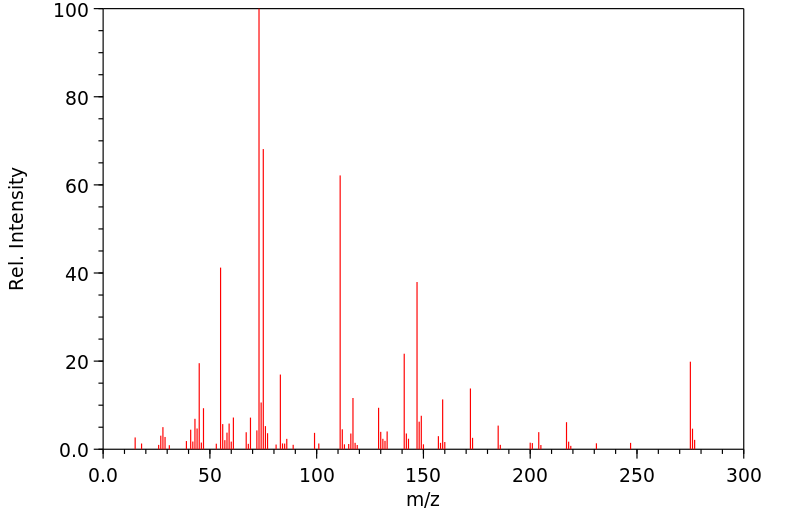己二酸二(三甲基硅酯) | 18105-31-2
中文名称
己二酸二(三甲基硅酯)
中文别名
——
英文名称
bis(trimethylsilyl) adipate
英文别名
bis(trimethylsilyl) hexanedioate
CAS
18105-31-2
化学式
C12H26O4Si2
mdl
——
分子量
290.507
InChiKey
DVGSOFSBBKDKRU-UHFFFAOYSA-N
BEILSTEIN
——
EINECS
——
-
物化性质
-
计算性质
-
ADMET
-
安全信息
-
SDS
-
制备方法与用途
-
上下游信息
-
文献信息
-
表征谱图
-
同类化合物
-
相关功能分类
-
相关结构分类
物化性质
-
沸点:134 °C
-
密度:0.948
-
闪点:75°C
-
保留指数:1525;1498;1504;1498;1497;1499;1499;1502;1490;1495.7;1502
计算性质
-
辛醇/水分配系数(LogP):3.3
-
重原子数:18
-
可旋转键数:9
-
环数:0.0
-
sp3杂化的碳原子比例:0.83
-
拓扑面积:52.6
-
氢给体数:0
-
氢受体数:4
安全信息
-
TSCA:Yes
-
安全说明:S26,S36
-
危险类别码:R36/37/38
-
海关编码:2931900090
SDS
上下游信息
-
下游产品
中文名称 英文名称 CAS号 化学式 分子量 —— trimethylsilyl 6-trimethylsiloxyhexanoate —— C12H28O3Si2 276.524 三甲基-(6-三甲基硅烷基氧基己氧基)硅烷 hexane-1,6-diol bis(trimethylsilyl) ether 6222-22-6 C12H30O2Si2 262.54
反应信息
-
作为反应物:描述:参考文献:名称:Larson, Gerald L.; Ortiz, Margarita; Roca, Marisol Rodriguez de, Synthetic Communications, 1981, vol. 11, # 7, p. 583 - 590摘要:DOI:
-
作为产物:参考文献:名称:ADAM, WALDEMAR;WANG, XIAOHENG, TETRAHEDRON LETT., 31,(1990) N, C. 1245-1248摘要:DOI:
文献信息
-
Partition coefficients of ketones, phenols, aliphatic and aromatic acids, and esters in n-hexane/nitromethane作者:Urszula Kotowska、Valery IsidorovDOI:10.2478/s11532-011-0060-4日期:2011.10.1in sample preparation and in countercurrent and liquid-liquid chromatographic separations. Partition coefficients are widely used in toxicology, environmental, and analytical chemistry. The K hn determination procedure for the n -hexane/nitromethane system was optimized and partition coefficients for 99 ketones, esters and trimethylsilyl derivatives of phenols, aliphatic and aromatic acids were determined
-
Synthesis of trimethylsilyl carboxylates by HMDS under solvent-free conditions作者:Marjan Jereb、Janja LaknerDOI:10.1016/j.tet.2016.08.003日期:2016.9carboxylic acids were transformed into their trimethylsilyl esters with HMDS in a practically completely solvent-free process, while a catalytic amount of iodine was required in some cases. The process has several advantages over the known methods: untreated reactants, air atmosphere, mild and neutral conditions, no evolution of hydrogen halide, no need of an additional base, low amount of waste, completely
-
Photooxygenation of 1,2-bis(silyloxy)cycloalkenes作者:Waldemar Adam、Xiaoheng WangDOI:10.1016/s0040-4039(00)88776-6日期:1990.1The reaction of singlet oxygen with O-silylated cyclic enediols 1a,b afforded as ene products the hydroperoxy silyl enol ethers 3a,b and as cleavage products the silyl esters 4a,b; the latter presumably derived from rearrangement of the intermediary silylperoxy ketones 2a,b.
-
Takano, Ryo; Kanda, Takashige; Hayashi, Kaeko, Journal of Carbohydrate Chemistry, 1995, vol. 14, # 6, p. 885 - 888作者:Takano, Ryo、Kanda, Takashige、Hayashi, Kaeko、Yoshida, Keiichi、Hara, SaburoDOI:——日期:——
-
Silyl reagents (Me3Si-X) efficiently transfer X to Ir(H)2F(PtBuP2Ph)2作者:Alan C. Cooper、John C. Huffman、Kenneth G. CaultonDOI:10.1016/s0020-1693(97)05851-9日期:1998.4Me3Si-X reagents react to completion at 25 degrees C in a short time to convert Ir(H)(2)FL2 (L = (PBu2Ph)-Bu-t) to Ir(H)(2)XL2. This involves formation of Ir-O, Ir-N, Ir-I, Ir-S and Ir-C(sp) bonds. Products include some pi(2)-X ligands such as carboxylate and acetamide, NHC(O)CH3. The acetamide is shown to be pi(2) in the solid state and in solution, but readily rearranges, by a transition state with Ir-O bond cleavage, to effect site exchange of the two inequivalent hydrides. The same synthetic approach succeeds for the more crowded metallated species and these reactions are shown to fail when F is replaced by Cl in the iridium reagent. Unsaturation at Ir is suggested to be central to the mechanism of these F/X transposition reactions. (C) 1998 Elsevier Science S.A.
表征谱图
-
氢谱1HNMR
-
质谱MS
-
碳谱13CNMR
-
红外IR
-
拉曼Raman
-
峰位数据
-
峰位匹配
-
表征信息
同类化合物
(2-溴乙氧基)-特丁基二甲基硅烷
鲸蜡基聚二甲基硅氧烷
骨化醇杂质DCP
马沙骨化醇中间体
马来酸双(三甲硅烷)酯
顺式-二氯二(二甲基硒醚)铂(II)
顺-N-(1-(2-乙氧基乙基)-3-甲基-4-哌啶基)-N-苯基苯酰胺
降钙素杂质13
降冰片烯基乙基三甲氧基硅烷
降冰片烯基乙基-POSS
间-氨基苯基三甲氧基硅烷
镓,二(1,1-二甲基乙基)甲基-
镁,氯[[二甲基(1-甲基乙氧基)甲硅烷基]甲基]-
锑,二溴三丁基-
铷,[三(三甲基甲硅烷基)甲基]-
铂(0)-1,3-二乙烯-1,1,3,3-四甲基二硅氧烷
钾(4-{[二甲基(2-甲基-2-丙基)硅烷基]氧基}-1-丁炔-1-基)(三氟)硼酸酯(1-)
金刚烷基乙基三氯硅烷
酰氧基丙基双封头
达格列净杂质
辛醛,8-[[(1,1-二甲基乙基)二甲基甲硅烷基]氧代]-
辛甲基-1,4-二氧杂-2,3,5,6-四硅杂环己烷
辛基铵甲烷砷酸盐
辛基衍生化硅胶(C8)ZORBAX?LP100/40C8
辛基硅三醇
辛基甲基二乙氧基硅烷
辛基三甲氧基硅烷
辛基三氯硅烷
辛基(三苯基)硅烷
辛乙基三硅氧烷
路易氏剂-3
路易氏剂-2
路易士剂
试剂Cyanomethyl[3-(trimethoxysilyl)propyl]trithiocarbonate
试剂3-[Tris(trimethylsiloxy)silyl]propylvinylcarbamate
试剂3-(Trimethoxysilyl)propylvinylcarbamate
试剂2-(Trimethylsilyl)cyclopent-2-en-1-one
试剂11-Azidoundecyltriethoxysilane
西甲硅油杂质14
衣康酸二(三甲基硅基)酯
苯胺,4-[2-(三乙氧基甲硅烷基)乙基]-
苯磺酸,羟基-,盐,单钠聚合甲醛,1,3,5-三嗪-2,4,6-三胺和脲
苯甲醇,a-[(三苯代甲硅烷基)甲基]-
苯并磷杂硅杂英,5,10-二氢-10,10-二甲基-5-苯基-
苯基二甲基氯硅烷
苯基二甲基乙氧基硅
苯基二甲基(2'-甲氧基乙氧基)硅烷
苯基乙酰氧基三甲基硅烷
苯基三辛基硅烷
苯基三甲氧基硅烷







